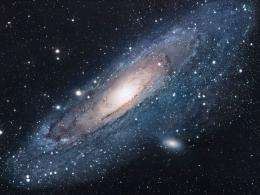The Cosmic Distance Scale

(PhysOrg.com) -- In 1908, Harvard astronomer Henrietta Swan Leavitt discovered that a class of stars called Cepheids have brightnesses that vary regularly with periods that are directly related to their intrinsic luminosities.
She calibrated this effect so that a comparison of the calculated and observed luminosity of a Cepheid can yield its distance. When Edwin Hubble began his study of galaxy velocities, he used Cepheid stars and Leavitt's relationship to determine their distances. This is how he discovered that galaxies are moving away from us, and that more distant galaxies are receding faster.
Today, the Hubble Space Telescope continues to use Cepheid stars to help calibrate the size of the universe, with the Cepheids fixing the distances to the nearest galaxies and thus anchoring a low rung of the cosmic distance ladder.
Dust in space (or around a star) will partially block starlight. In the case of Cepheids, for which the total measured luminosity is a key parameter, dust can therefore complicate the calibration. Moreover, the presence of circumstellar dust is of interest to astronomers working to understand the detailed mechanisms of Cepheid pulsations and the stage of stellar evolution when they occur. If a Cepheid star has a wind that ejects dust, for example, that wind will reflect the internal chemical evolution of the star.
SAO astronomers Massimo Marengo, Nancy Evans, and Pauline Barmby, along with three colleagues, have used the Infrared Array Camera on the Spitzer Space Telescope to make the first detailed study of Cepheid variable stars at mid-infrared wavelengths, where the effect of extinction by dust is greatly reduced.
Writing in this month's Astrophysical Journal, they find that the star's period is significantly correlated with its infrared color, as well as its luminosity, a finding that can help solidify the distance calibrations. They also report that, unlike many suggested scenarios, there is no evidence for warm circumstellar dust around Cepheids, implying that if there are winds from these stars, they do not contain much dust.
Provided by Harvard-Smithsonian Center for Astrophysics



















